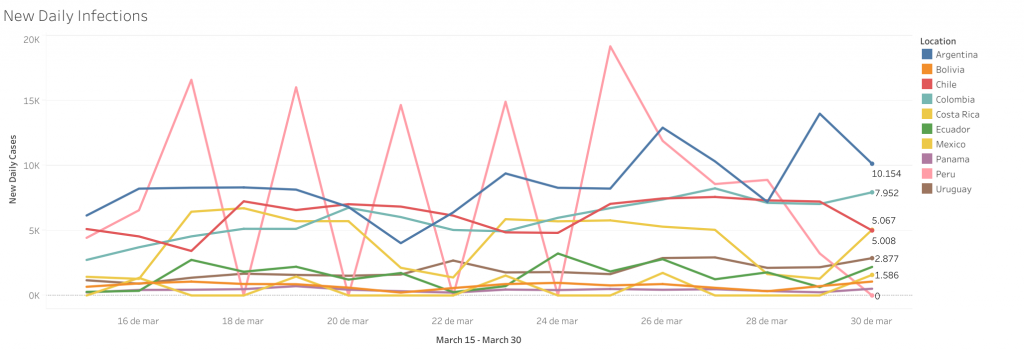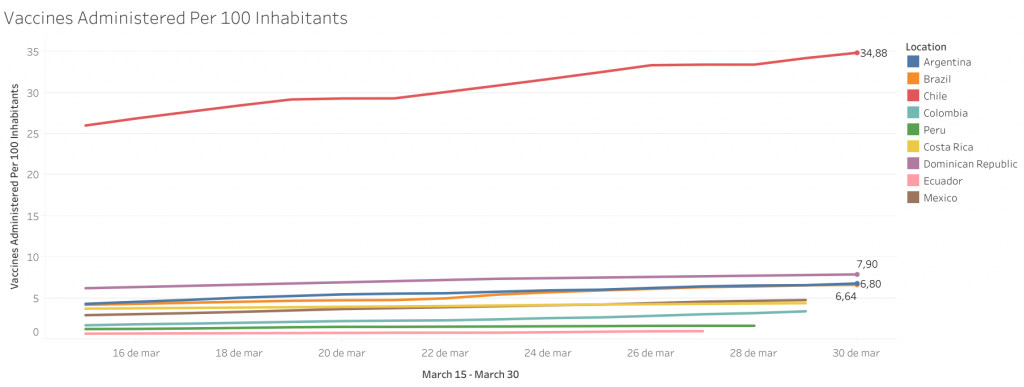What You Should Know
- PAHO: Pan American Health Organization (PAHO) Director, Dr. Carissa Etienne, urged maintaining COVID-19 protocols and safeguards, even with vaccinations underway in several countries.
- Indigenous communities: The UN is urging governments to support indigenous communities by recognizing their role in protecting forests. Nearly half of the forest in the Amazon basin and 35 percent of all forests in Latin America are protected by indigenous peoples, but COVID-19 has worsened their ability to preserve forests and wildlife.
- Israel-LAC: The Inter-American Development Bank and Healthcare Israel have signed an agreement to provide digital health expertise, training, and solutions to improve lives in Latin America and the Caribbean.
- 13.8 Percent: Chile reported its highest positivity rate for COVID-19 tests in more than 8 months. Here are this week’s figures.
Health + Innovation
- Mexico: The government has revealed that the country’s true death toll from the pandemic stands above 321,000, nearly 60 percent higher than the official test-confirmed number of 201,429.
- Suriname: On March 26, Suriname received 24,000 COVID-19 vaccines doses through the COVAX Facility. Suriname is expected to continue receiving doses throughout 2021 for up to 20 percent of its population.
- Canada: The Government will contribute $950,000 to support PAHO’s efforts to fight COVID-19 in six Caribbean countries. The donation will be used to acquire essential personal protection equipment, laboratory and medical equipment, and supplies to be used by health care workers and hospitals in the Bahamas, Belize, Guyana, Jamaica, Suriname, and Trinidad and Tobago.
- Trinidad and Tobago: On March 30, 33,600 initial doses (about one-third of this country’s first allocation of COVID-19 vaccines from COVAX) arrived at Piarco Airport.
- Brazil: On March 23, Brazil reported 3,251 COVID-19 deaths, its highest daily death toll since the outbreak. On that day, one in three COVID-19 deaths worldwide were Brazilian. Researchers from Fiocruz – Brazil’s leading scientific research and development institution – have identified potentially more transmissible variants than the P.1. strain.
- Cuba: On March 29, Cuba began testing its second COVID-19 vaccine – Abdala – on tens of thousands of health care workers. The vaccine has yet to complete clinical trials.
Economies in Focus
Multilateral Analysis
- UN Secretary-General Antonio Guterres, alongside the prime ministers of Canada and Jamaica, called for greater action to prevent a debt crisis, including extending the moratorium on debt repayments and providing cash liquidity to developing countries for their COVD-19 response and recovery plans.
- IMF Managing Director Kristalina Georgieva warned that there is “a dangerous divergence in economic fortunes within countries and across countries” as a result of COVID-19 and urged governments to invest in a greener, more inclusive, and more resilient future.
- The World Bank’s Renewing with Growth report finds that the immense disruption from the pandemic may lead to higher productivity through economic restructuring and digitalization.
Economic Relief
- The Japanese Bank for International Cooperation extended a new credit line of $90 million to the CAF development bank to support public health systems and protect the region’s most vulnerable during the COVID-19 pandemic.
- The World Bank issued a loan of $250 million to strengthen Argentina’s health care system.
- The Central American Bank for Economic Integration (CABEI) issued a grant of $500,000 to Honduras to provide care to the population through the Juan Pablo II COVID-19 Stabilization Center.
- CABEI also issued a grant of $500,000 to the Dominican Republic to support efforts to combat the effects of COVID-19.
Economic Impact
- Mexico fell from the sixth to the seventh largest manufacturer of cars because of pandemic-induced production slowdowns. The country experienced a 20.8 percent drop in production during 2020 compared to the previous year.
- Latin American currencies weakened on March 29 against the US dollar as the United States’ economic outlook continues to improve. The Chilean peso showed the greatest decline, slipping 0.8 percent.
- Argentina’s exports fell by 16 percent, the worst drop in 27 years according to Fundación Mediterránea.
Quarantines + Travel Restrictions
Quarantines + Reopenings
- 97 percent of Chileans entered total quarantine on March 27, as new daily cases broke records. Hospital occupation has reached 95 percent.
- The Colombian province of Antioquia, which includes Medellín, implemented a nightly curfew and prohibited alcohol sales beginning at 5:00 p.m. and ending at 5:00 a.m. from March 31 to April 5.
- Ecuadorian authorities acknowledged a regression in the country’s COVID-19 fight and called upon local authorities to close beaches, limit alcohol sales, and establish restrictions on movement from April 1 to April 4.
Border and travel restrictions
- Honduran authorities increased border restrictions for citizens who have visited South America in the last 15 days amid concerns over the new P.1. variant. Travelers must now present a negative PCR test taken no more than 72 hours before the flight.
- Panama announced that it would require travelers coming from South America to present a negative COVID-19 test taken no more than 48 hours before traveling and upon arrival undergo another COVID-19 test at the traveler’s expense and quarantine for five days.
- As of March 31, in addition to presenting a negative PCR test conducted no more than three days before traveling, all travelers arriving in Chile must undergo another COVID-19 test upon arrival and quarantine for five days.
- On March 29, Argentina announced that citizens who have left the country between December 25, 2020 and April 1, 2021 will not be allowed to cross land borders to return home and instead must fly to one of the few authorized airports.
- Guatemalan President Alejandro Giammattei issued a decree restricting open-air gatherings and demonstrations along Guatemala’s border with Honduras until April 12, amid COVID-19 concerns and rumors that a new migrant caravan may be forming along the border.
- Costa Rica will reopen its borders on April 5 to tourists provided that visitors present health insurance for their entire stay and financial means to cover any unforeseen quarantine costs.
In Focus: Latin America Braces for Semana Santa
- Latin America is implementing restrictions across the board and urging citizens to stay home to avoid a spike in COVID-19 cases during “Semana Santa,” the week-long celebration leading up to Easter.
- In Mexico, authorities canceled the procession of the Passion of Christ, which normally draws a million people to Mexico City. In Brazil, citizens are flocking to the coasts, ignoring authorities’ recommendations.
- As a deterrent, many local and state authorities have implemented curfews and other restrictions, including the cities of São Paulo and Rio de Janeiro and most major cities in Colombia. PAHO Subdirector Dr. Jarbas Barbosa expressed concern that the region would experience an increase in cases like the one observed during the Christmas holidays.
- Nonetheless, Latin American airlines increased their seat capacities by at least 5 percent, anticipating an increase in travelers. If the airlines’ prediction is correct, this will be the best week for the industry this year.
By the numbers
- Cases by country: Brazil (12,664,058) #2 worldwide, Colombia (2,397,731) #11 worldwide, Argentina (2,332,765) #12 worldwide, Mexico (2,232,910) #14 worldwide, Peru (1,540,077) #18 worldwide, Chile (995,538) #22 worldwide, Panama (354,604) #44 worldwide, Ecuador (328,755) #47 worldwide, Bolivia (271,419) #52 worldwide, Dominican Republic (252,171) #55 worldwide, Source: worldometers.info
- Prevalence rate (total cases per million people: Aruba (87,522) #10 worldwide, Panama (81,236) #12 worldwide, Brazil (59,265) #42 worldwide, Chile (51,748) #50 worldwide, Argentina (51,265) #51 worldwide, Curacao (47,985) #55 worldwide, Colombia (46,752) #57 worldwide, Costa Rica (42,265) #63 worldwide, Saint Martin (41,350) #65 worldwide, Belize (30,809) #76 worldwide, Source: worldometers.info
- Deaths per capita (deaths per million people): Mexico (1,559) #17 worldwide, Peru (1,555) #18 worldwide, Brazil (1,488) #19 worldwide, Colombia (1,233) #28 worldwide, Argentina (1,225) #31 worldwide, Chile (1,203) #32 worldwide, Bolivia (1,038) #36 worldwide, Ecuador (944) #41 worldwide, Aruba (794) #47 worldwide, Belize (787) #48 worldwide, Source: worldometers.info
Quick take


